1950s
Harmonica Record
Obscure world record: longest time playing the harmonica while sitting in a chair balanced on top of three wine bottles. Set by Michel Perrigaud in 1959, who played for seven-and-a-half hours.
Albuquerque Journal - Jan 29, 1959
Posted By: Alex - Mon Apr 08, 2024 -
Comments (1)
Category: Music, World Records, 1950s
Beatniks Under the Microscope

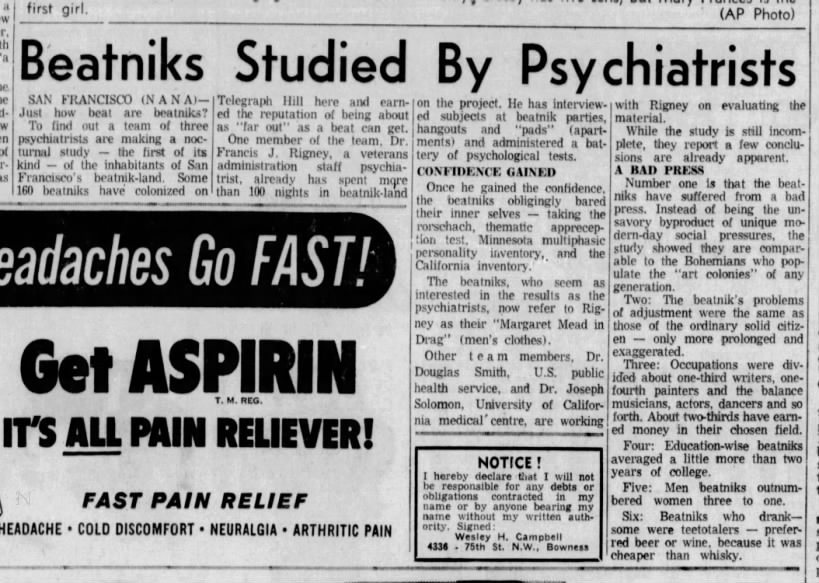
Posted By: Paul - Wed Mar 27, 2024 -
Comments (0)
Category: Science, Bohemians, Beatniks, Hippies and Slackers, 1950s
An Upside-Down Experiment
In 1950, graduate student Fred Snyder of the University of Wichita spent 30 days wearing special glasses that inverted his vision. It was part of an experiment designed by Dr. N.H. Pronko, head of the psychology department, to see if a person could adapt to seeing everything upside-down. The answer was that, yes, Snyder gradually adapted to inverted vision. And when the experiment ended he had to re-adapt to seeing the world right-side-up.Snyder and Pronko described the experiment in their 1952 book, Vision with Spatial Inversion. From the book's intro:
Such an experiment is out of the question, of course. Yet another experiment was made: a young man was persuaded to wear inverting lenses for 30 days, and his experiences are reported here. His continued progress, after an initial upset, suggests that new perceptions do develop in the same way as the original perceptions did. Life situations suggest the same thing. Dentists learn to work via a mirror in the patient's mouth until the action is automatic. In the early days of television, cameramen had to "pan" their cameras with a reversed view. Later the image in the camera was corrected to correspond with the scene being panned. The changeover caused considerable confusion to cameramen until they learned appropriate visual-motor coordinations. Fred Snyder, the subject of our upside-down experiment, found himself in a similar predicament, at least for a time.
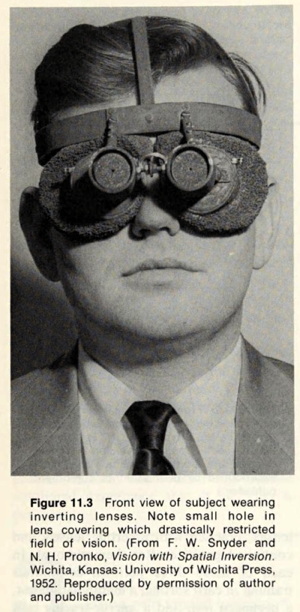
Images from Life - Sep 18, 1950:
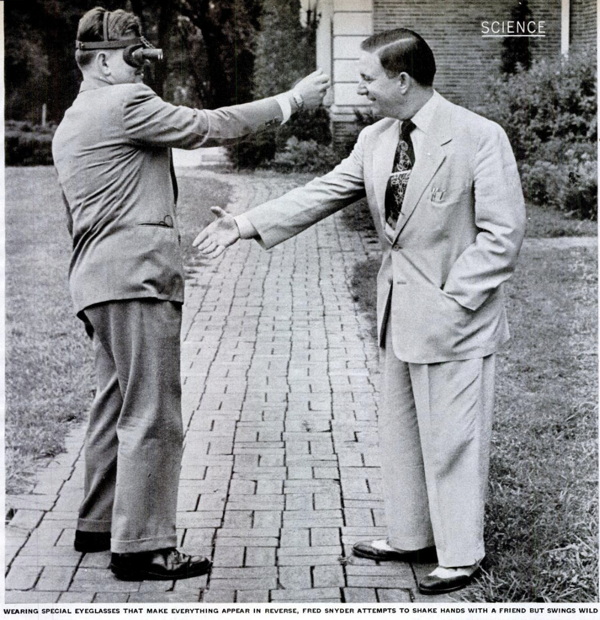
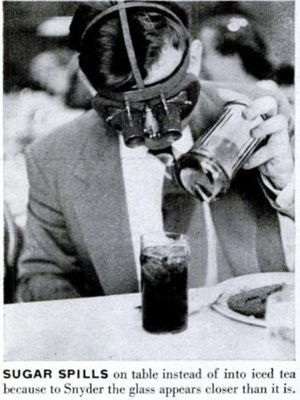
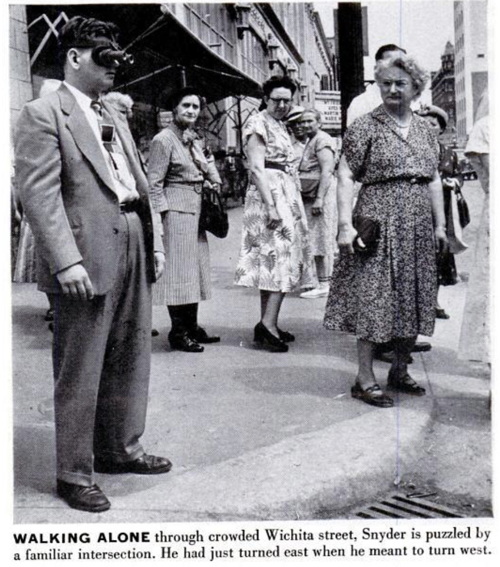
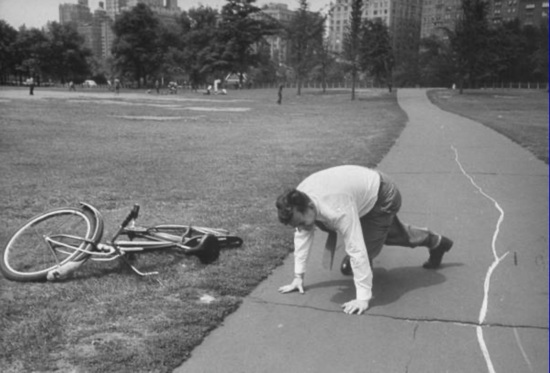
"Graduate student Fred Snyder falling down after removing special eyeglasses that reverse and invert everything he sees. Immediately before removing glasses he rode a bicycle with perfect control along sidewalk in Central Park."
Posted By: Alex - Mon Mar 25, 2024 -
Comments (2)
Category: Experiments, 1950s, Eyes and Vision
Defecation relief unit for aeroplane personnel
How do fighter pilots poop while in the air? I think the answer is that they try very hard not to, because if they have to go, they're going in their flight suit. Back in the 1950s Constantin Paul Lent, et al., tried to come up with an alternative. From their patent (No. 2,749,558):Comparatively speaking it is an easy matter to provide adequate latrines for the men in the forces on land and sea. When the time comes to eliminate, one just walks to the nearest comfort station. But in the Air Force the problem of elimination can not be always solved that easily especially by aviation pilots...
The applicants are cognizant that there are relief tubes provided on most all jet planes for urinating, but no single seat aircraft is equipped with a safe and sure means for defecation. When the pilot of the jet, due to accident or enemy action needs to eliminate, the problem of defecation becomes acute. The pilot must wait until he lands his craft; and quite often he must remain aloft for a considerable length of time before he has a chance to visit a comfort station on the ground. In many cases due to the physiological and psychological effects produced on the pilot by enemy action, he is forced to eliminate even before he has a chance to land his plane.


Posted By: Alex - Sun Mar 24, 2024 -
Comments (0)
Category: Flight, Patents, Excrement, Air Travel and Airlines, 1950s
For relief of emotional stress
For housewives on the verge of a nervous breakdown.
Medical Economics - Mar 2, 1959
Posted By: Alex - Wed Mar 20, 2024 -
Comments (1)
Category: Medicine, Psychology, 1950s
Weird Easter Hats
The strange hats appear about halfway thru.
Posted By: Paul - Fri Mar 15, 2024 -
Comments (0)
Category: Holidays, Easter, Headgear, 1950s, United Kingdom
Person-Alysis Game
Reveal which member of the family has an Oedipus Complex! Who's a sociopath? Good fun!The entry at Board Game Geek.


Posted By: Paul - Thu Mar 14, 2024 -
Comments (0)
Category: Bad Habits, Neuroses and Psychoses, Games, Hobbies and DIY, Psychology, 1950s
Miss Electric Bedding
Advertising Age ran a photo of "Miss Electric Bedding" in its Nov 10, 1952 issue. But it didn't give her name.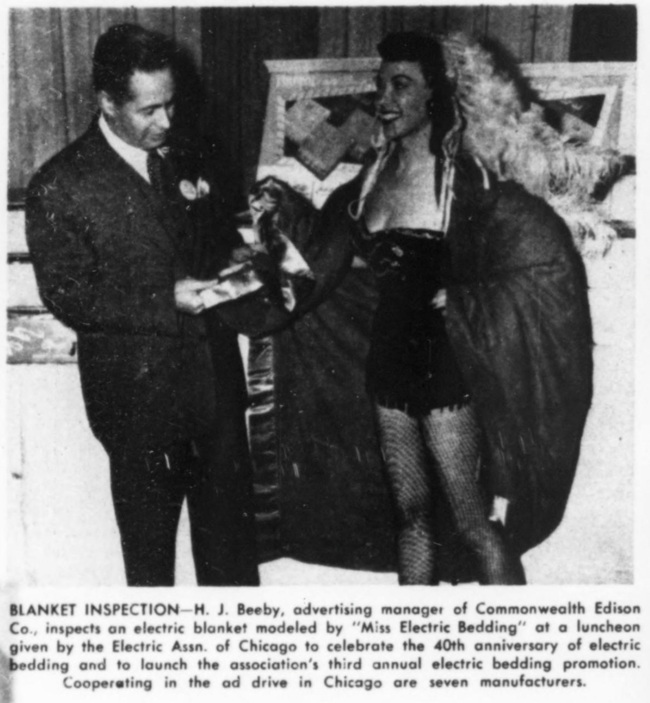
Advertising Age - Nov 10, 1952
A month later, reports appeared in a number of newspapers stating that actress Viveca Lindfors had declined to be crowned "Miss Electric Bedding."
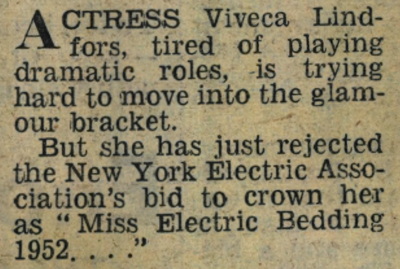
Daily Mirror - Dec 16, 1952
I'm not sure if that's Viveca Lindfors in the Advertising Age photo, but it definitely could be. I'm leaning towards thinking it is. And if it is, it's confusing why it was reported that she declined to be Miss Electric Bedding. After all, there she is.
My best guess: the Advertising Age photo shows her modeling as Miss Electric Bedding for the Chicago Electric Association. The later news report says she refused an offer from the New York Electric Assn. So she must have done the electric bedding modeling gig in Chicago, but then declined to do it elsewhere.

Viveca Lindfors - image source: wikipedia
Posted By: Alex - Sun Mar 10, 2024 -
Comments (1)
Category: Awards, Prizes, Competitions and Contests, 1950s
Husbands too like Premarin
Make your wife pleasant again with Premarin!By the 1990s, Premarin had become the most frequently prescribed medication in the United States. Now, according to Wikipedia, it's down to number 283.
The word 'Premarin' is a portmanteau of PREgnant MAre uRINe.


Posted By: Alex - Tue Mar 05, 2024 -
Comments (1)
Category: Medicine, Advertising, Husbands, Wives, 1950s
Falsies on Freeway
Falsies, or miniature Kendall paracones?
Los Angeles Times - Oct 26, 1954

Rushville Republican - Oct 26, 1954
Posted By: Alex - Sat Mar 02, 2024 -
Comments (0)
Category: Transportation, 1950s

| Who We Are |
|---|
| Alex Boese Alex is the creator and curator of the Museum of Hoaxes. He's also the author of various weird, non-fiction, science-themed books such as Elephants on Acid and Psychedelic Apes. Paul Di Filippo Paul has been paid to put weird ideas into fictional form for over thirty years, in his career as a noted science fiction writer. He has recently begun blogging on many curious topics with three fellow writers at The Inferior 4+1. Contact Us |




